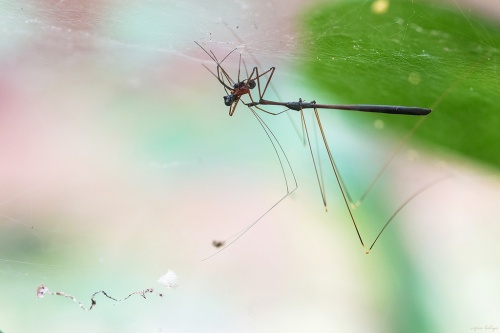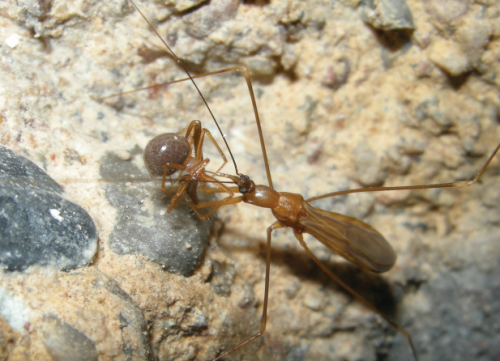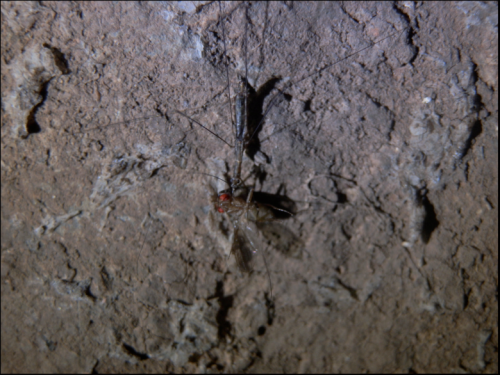by Piter Kehoma Boll
If you think spiders are scary creatures, today you will learn that they are scared too. But what could scary a spider? Well, a web bug!
We usually think of spider webs as an astonishing evolutionary achievement of this group of arachnids and a very efficient way to capture prey without having to pursue them. Webs are sticky, resistant, and only spiders themselves can move freely through them. The only problem is that this is not true.

A thread-legged assassin bug (Emesaya sp.) feeding on a spider after invading the spider’s web in the Western Ghats, India. Photo by Vipin Baliga.*
A group of bugs that conquered the spider world are the so-called thread-legged assassin bugs, which comprise the subfamily Emesinae of the assassin bugs (family Reduviidae). As the name implies, the assassin bugs are a group of true bugs (suborder Heteroptera) that are expert killers of other creatures.
During their evolution, the thread-legged assassin bugs seem to have acquired a special taste for spiders and throughout the world they are usually associated with these eight-legged predators. In many cases, such as the one seen in the picture above, the bugs prey on the spiders, having developed the ability to move through the webs. They usually produce vibrations on the web that attract the spiders. Those, thinking that they caught a prey, are lured directly to their death in the legs and proboscis of the terrible bug.
Some thread-legged assassin bugs have, however, found another way to harass spiders: by stealing their food. In the latter scenario, the bugs usually wait close to or on the spider’s web and, when an insect is caught, they steal it from the spider by ripping it off the web. This kind of behavior is called kleptoparasitism, which means “parasitism by stealing”.
But how can spiders avoid this bug nightmare?
Until recently, it was thought that spiders were safe inside caves. Although emesinid bugs do occurr in caves, their association with spiders seemed to be weaker or non-existent there. But new findings are revealing that they pursue our arachnid fellows even to the deepest abysses of Earth.
The earliest cave-dwelling thread-legged assassin bug known to prey on spiders is Bagauda cavernicola, from India. Its spider-eating habits are known since the first decades of the 20th century.
The second species, Phasmatocoris labyrinthicus, was found almost a century later, in 2013, in Arizona, USA. More than only preying on spiders, such as the species Eidmanella pallida that lives in the same cave, P. labyrinthicus seem to have developed the ability to manipulate abandoned spiderwebs and use them to detect and capture prey for their own consumption. Only a single instance of such a behavior has been recorded and the species’s behavior needs further studies.

Phasmatocoris labyrinthicus feeding on the spider Eidmanella pallida in the Kartchner Caverns, Arizona, USA. Photo extracted from Bape, 2013.
Now, only 3 years later, there are new evidences of more thread-legged assassin bugs molesting spiders in caves. And this time the observations were made in Minas Gerais, Brazil. One individual of the bug species Emesa mourei was seen standing on the web of a recluse spider (Loxosceles similis) while the spider was at the web’s edge. Another specimen of E. mourei was seen feeding on a fly near the web of a pholcid (cellar spider). The fly and the legs of the bug had vestiges of silk, indicating that the bug stole the fly from the spider. Another bug species, Phasmatocoris sp., was observed on a web of the cellar spider Mesabolivar aff. tandilicus. If this species of Phasmatocoris manipulates spider webs the same way that P. labyrinthicus seems to do is something yet to be investigated.

Nymph of Emesa mourei feeding on a fly that it apparently stole from a pholcid spider in the cave Lapa Arco da Lapa, Minas Gerais, Brazil. Photo by Leonardo P. A. Resende, extracted from Resende et al., 2016.
With three different and very distant records of thread-legged assassin bugs associated with spiders in caves, it is clear that the poor arachnids cannot get rid of those bugs even if they run down into the bowels of the Earth.
– – –
PAPE, R. (2013). Description and Ecology of A New Cavernicolous, Arachnophilous Thread-legged Bug (Hemiptera: Reduviidae: Emesini) from Kartchner Caverns, Cochise County, Arizona Zootaxa, 3670 (2) DOI: 10.11646/zootaxa.3670.2.2
Resende, L., Zepon, T., Bichuette, M., Pape, R., & Gil-Santana, H. (2016). Associations between Emesinae heteropterans and spiders in limestone caves of Minas Gerais, southeastern Brazil Neotropical Biology and Conservation, 11 (3) DOI: 10.4013/nbc.2016.113.01
Wignall, A., & Taylor, P. (2010). Predatory behaviour of an araneophagic assassin bug Journal of Ethology, 28 (3), 437-445 DOI: 10.1007/s10164-009-0202-8
Wygodzinsky, P. W. 1966. A monograph of the Emesinae (Reduviidae, Hemiptera). Bulletin of the American Museum of Natural History, 133:1-614.
– – –
*
This work is licensed under a Creative Commons Attribution-NonCommerical-NoDerivs 2.0 Generic License.

Pingback: Going deep with your guts full of microbes: a lesson from Chinese fish | Earthling Nature